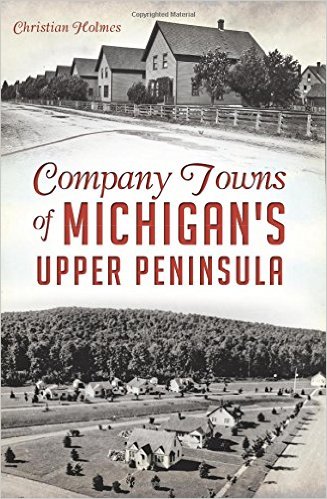By ERIC FREEDMAN
Capital News Service
LANSING — They were shaped by the mines, forests and quarries of the Upper Peninsula — and by the companies that owned those resources.
They were communities that drew workers to the UP from across the globe in search of jobs and opportunities.
And today they’re largely gone. Some, like Ford River, Nahma and Pequaming, still rate a pinprick on the official Michigan Department of Transportation highway map. Some, like Simmons, Shelldrake and Emerson are nowhere to be found on that map, even with a magnifying glass.

Photo Credits: History Press
Less than a handful — Sault Ste. Marie, Newberry and Kingsford — have populations large enough to be listed on the map.
Now a new book by Escanaba writer Christian Holmes, “Company Towns of Michigan’s Upper Peninsula” (History Press, $21.99) chronicles their tales.
The retired dean and librarian at Bay de Noc Community College became interested in the topic when he saw a museum exhibit about the 1951 sale of the entire town of Nahma in Delta County.
The Indiana recreation firm that bought Nahma promised to provide jobs “for a sizeable number of people in the town,” but that promise wasn’t fulfilled, and what had been a peak of about 250 workers dropped to around 50, Holmes said.
As part of his research, Holmes visited all the company towns featured in the book — almost 20 — but he estimates that the U.P. was home to about triple that number, such as the many company towns on the Keweenaw Peninsula.
“I talked to some people who either worked in the company town or grew up in the company town,” he said.
In the book, Holmes wrote, “It is impossible to overlook the emotional side of this story. The individuals who lived in these towns experienced remarkable hardships. Working conditions were arduous: logging was done in the winter snow, ice and very low temperatures. The mines were no better — dirty, dangerous work underground by candlelight, with cool stale air and the threat of premature explosion of dynamite or cave-ins.”
The companies that owned them provided a range of services to “attract and maintain workers in remote, resource-rich locations,” from housing to medical services to stores, according to Holmes. But the companies also strove to keep unions out and to pressure residents on whom to vote for.
Holmes said his biggest surprise from his interviews was learning that “there were a good number of people satisfied with the company-owned model as employees and residents. The stability that was offered through employment offset what was perceived as sometimes not being treated as fair as possible or with equity.”
In that sense, conditions in U.P. company towns were “not as bleak as elsewhere,” including mining towns in coal country and in the West, he said.
As the book explains, the roots and legacies of these communities vary.
Consider Shelldrake, founded by a lumber company in 1895 and once boasting a hospital, school, boardwalk and boardinghouse. South of Lake Superior’s Whitefish Point, it can’t be found on the MDOT map, and it’s commemorated only by a roadside historical marker.
Consider Fiborn, a one-time limestone quarrying town in Mackinaw County whose residents “represented a wide variety of European ethnic backgrounds and a mixture of immigrants and those born in the United States,” according to the book. Its first road for cars wasn’t built until 1916, and its one-room schoolhouse closed in the 1930s. In 1987, the nonprofit Michigan Karst Conservancy bought it from its Canadian corporate owner for use as a nature preserve.
One survivor that fared better is Kingsford. It boomed in the 1920s when Ford Motor Co. started building cars there that used wooden components with as many as 7,500 employees. A downslide occurred during World War II because of reduced auto manufacturing, and in 1961 a Ford successor shut down its charcoal briquette production.
It’s now a “small, thriving community” with shops and small businesses, manufacturing facilities and three museums that draw tourists, the book noted.